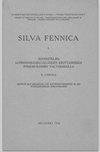Annual net nitrogen mineralization and litter flux in well-drained downy birch, Norway spruce and Scots pine forest ecosystems
IF 1.7
3区 农林科学
Q2 FORESTRY
引用次数: 10
Abstract
The main aim of the current study was to estimate the annual net nitrogen mineralization (NNM) flux in stands of different tree species growing on drained peatlands, as well as to clarify the effect of tree species, soil properties and litter on annual NNM dynamics. Three study sites were set up in May 2014: a downy birch (Betula pubescens Ehrh.) stand and a Norway spruce (Picea abies (L.) Karst.) stand in Oxalis full-drained swamp (ODS) and a Scots pine (Pinus sylvestris L.) stand in Myrtillus full-drained swamp (MDS). The NNM flux was estimated using the in situ method with incubated polyethylene bags. The highest value of NNM was found in stands that were growing on fertile ODS: 127.5 kg N ha–1 yr–1 and 87.7 kg N ha–1 yr–1, in the downy birch stand and in the Norway spruce stand, respectively. A significantly lower annual NNM flux (11.8 kg N ha–1 yr–1) occurred in the Scots pine stand growing in MDS. Nitrification was highest at fertile ODS sites and ammonification was the highest at the low fertility MDS site. For all study sites, positive correlation was found between soil temperature and NNM intensity. The difference in annual NNM between the downy birch stand and the Norway spruce stand growing on similar drained fertile peatlands was due to litter quality. The annual N input into the soil through leaf litter was the highest at the downy birch site where also the C/N ratio of litter was the lowest. The second highest N input into the soil was found in the spruce stand and the lowest in the pine stand.排水良好的软毛桦、挪威云杉和苏格兰松林生态系统的年净氮矿化和凋落物通量
本研究的主要目的是估算排干泥炭地不同树种林分的年净氮矿化通量,并阐明树种、土壤性质和凋落物对年净氮矿化动态的影响。2014年5月建立了三个研究地点:一个毛桦(Betula pubescens Ehrh.)林分和一个挪威云杉(Picea abies (L.))林分。Oxalis全干沼泽(ODS)中的喀斯特(Karst)林和Myrtillus全干沼泽(MDS)中的苏格兰松(Pinus sylvestris L.)林。采用聚乙烯袋原位法对NNM通量进行了估算。在肥沃ODS上生长的林分中,NNM值最高,分别为127.5 kg N ha-1年- 1和87.7 kg N ha-1年- 1,分别为毛桦林和挪威云杉林。MDS中生长的苏格兰松林的年NNM通量(11.8 kg N ha-1年- 1)显著低于其他林分。氮化作用在肥沃的ODS位点最高,氨化作用在低肥力的MDS位点最高。在所有研究点,土壤温度与NNM强度呈正相关。生长在相似排水肥沃泥炭地上的白桦林分和挪威云杉林分的年NNM差异主要是由于凋落物质量。年通过凋落叶对土壤的氮输入量以白桦立地最高,凋落叶的碳氮比最低。云杉林土壤氮输入量次之,松林最低。
本文章由计算机程序翻译,如有差异,请以英文原文为准。
求助全文
约1分钟内获得全文
求助全文
来源期刊

Silva Fennica
农林科学-林学
CiteScore
3.50
自引率
11.10%
发文量
21
审稿时长
3 months
期刊介绍:
Silva Fennica publishes significant new knowledge on forest sciences. The scope covers research on forestry and forest ecosystems. Silva Fennica aims to increase understanding on forest ecosystems, and sustainable use and conservation of forest resources. Use of forest resources includes all aspects of forestry containing biomass-based and non-timber products, economic and social factors etc.
 求助内容:
求助内容: 应助结果提醒方式:
应助结果提醒方式:


